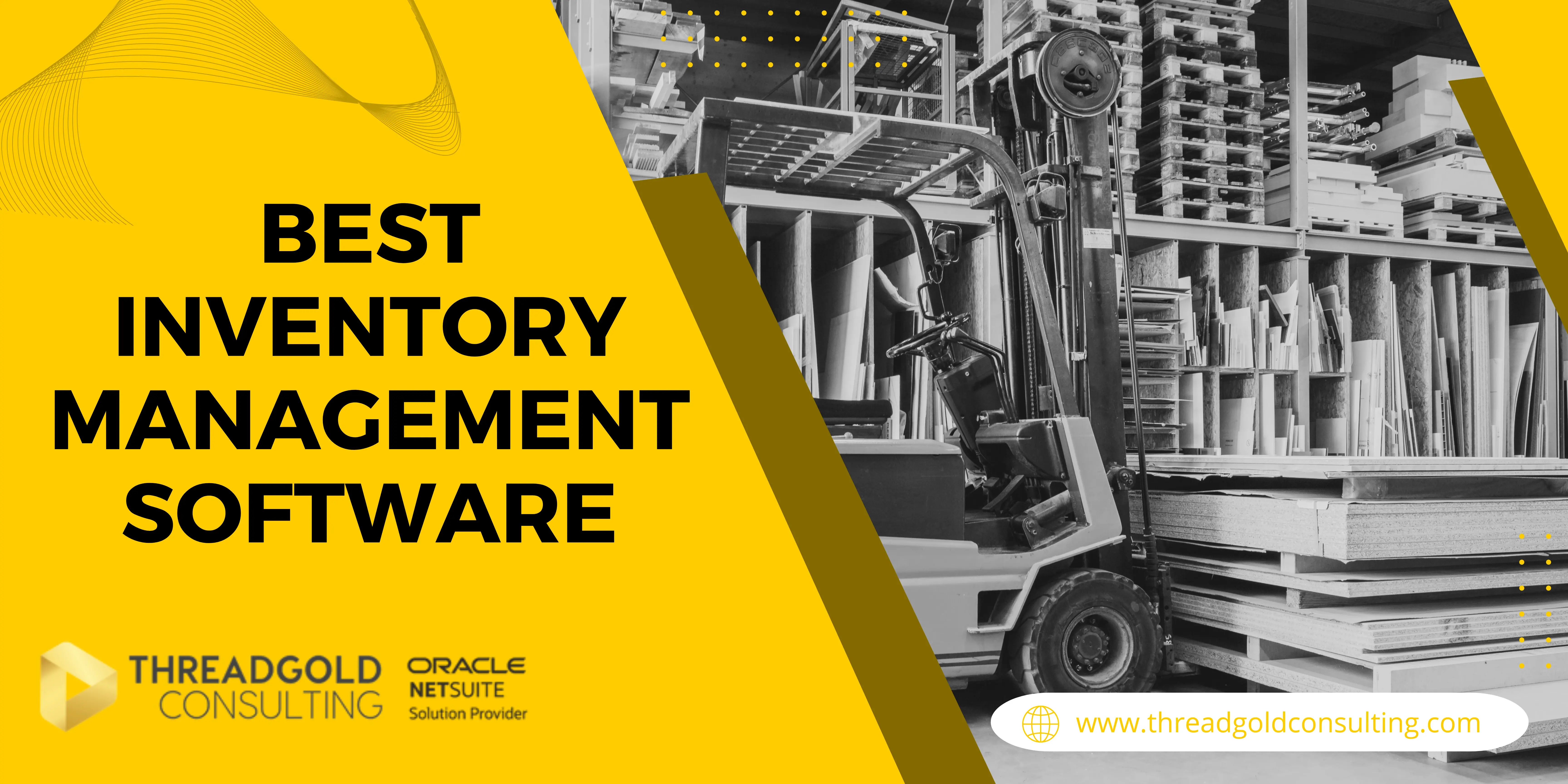Managing inventory effectively is one of the biggest challenges that scaling companies face. A good inventory management system gives you real-time visibility, automates replenishment, and integrates with sales, finance, and operations. With hundreds of platforms available, knowing which one is best for your business can be overwhelming.
In this guide, we explore eight of the best inventory management systems on the market today. These platforms cover a range of company sizes, from growing startups to multinational enterprises, with a slight emphasis on NetSuite due to its all-around scalability.
1. NetSuite Inventory Management (Oracle NetSuite)
NetSuite inventory management is part of Oracle NetSuite's unified ERP platform, meaning inventory is seamlessly connected with sales, purchasing, and finance. It offers real-time, multi-location stock tracking, demand-driven replenishment, and Smart Count for automated cycle counts. Advanced features like lot/bin/serial tracking and AI-powered forecasting make it a go-to choice for businesses that require precision. For companies with international operations, NetSuite’s scalability and global compliance support are unmatched. While it comes with a learning curve, it often becomes the backbone for growing organizations.
Key Features
- Real-time multi-location inventory tracking
- Smart Count automated cycle counts
- Demand-driven replenishment
- Lot/bin/serial number tracking
- AI-driven forecasting and analytics
- Full integration with finance, CRM, and e-commerce
Pricing
- Base system: $999/month
- User licenses: $99–$149/user/month
- Add-on modules: $600–$2,000/month per module
- Implementation: 2–3× annual license fees
Check out our pricing guide for more info, or receive your personalised license & implementation quote using our pricing calculator below!
Challenges
NetSuite is often considered complex to set up, particularly for small teams, and the implementation process can take several months. Reviewers frequently highlight that its extensive features demand significant training to fully leverage. Many also mention that while powerful, the overall price structure is high, making it less accessible for smaller companies.
Reviews
According to Gartner Peer Insights: “NetSuite is a robust ERP system that grows with the company and is very flexible” (Gartner Peer Insights, 2024). On G2, one user wrote: “I like the ability to integrate everything from finance to warehouse processes seamlessly. It becomes the backbone of operations.” Another review notes that the platform “has helped us gain visibility across global warehouses and made decision-making far more data-driven.”
2. Katana Cloud Inventory (Katana MRP)
Katana focuses on small to mid-sized manufacturers who need visibility across production and stock. It combines inventory with MRP features like bill-of-materials planning, shop floor control, and scheduling. A simple, intuitive interface lets teams manage stock and production workflows without heavy training. Integrations with Shopify, Xero, QuickBooks, and WooCommerce make it easy to keep finance and operations aligned. Businesses value its real-time insights for avoiding shortages and overstocking.
Key Features
- Real-time inventory tracking with bill-of-materials planning
- Production scheduling and shop floor management
- Batch and serial number traceability
- Barcode scanning and mobile access
- Integrations with Shopify, QuickBooks, Xero, WooCommerce
Pricing
- Starter: $179/month
- Standard: $359/month
- Professional: $799/month
- Professional Plus: $1,999/month
Challenges
Some have mentioned occasional bugs and performance slowdowns when managing very large datasets. Others point out that while Katana starts affordable, pricing can grow quickly as operations expand. Finally, some small companies find that customer support can sometimes take time to respond during peak periods.
Reviews
One Capterra review states: “Katana is intuitive, easy to learn, and integrates seamlessly with Shopify. It saves us hours of manual work every week.” Another reviewer wrote, “Katana makes production scheduling a breeze and has eliminated stockouts in our workshop.” Many users emphasize that Katana “provides excellent value for money for smaller manufacturers looking to digitize their processes.”
3. Cin7 Core / Cin7 Omni
Cin7 is an excellent solution for retailers, wholesalers, and distributors who need multi-channel synchronization. It handles orders, stock, warehouse tasks, and light manufacturing while automating complex workflows. Cin7 Core provides solid tools for medium-sized companies, while Cin7 Omni adds features like EDI and 3PL integrations for larger operations. Its automation significantly reduces manual errors and time spent on repetitive tasks.
Key Features
- Multi-channel order and inventory management
- Automated workflows and EDI support (Omni)
- Integration with 3PL logistics providers
- Light manufacturing and assembly features
- Real-time warehouse and stock tracking
Pricing
- Standard: $349/month
- Pro: $599/month
- Advanced: $999/month
Challenges
Users have reported that onboarding can be complex due to the number of features available. Others mention that advanced functionality like EDI and 3PL support significantly increases the cost. There is also feedback that the interface requires time to master, making the first months of adoption challenging.
Reviews
A G2 reviewer wrote: “Cin7 helped us automate our workflows so that we could focus on growing sales instead of managing spreadsheets.” Another review adds: “The implementation requires time and commitment, but once running, it’s very powerful.” A third reviewer says: “Cin7 is perfect for multi-channel inventory but be prepared to invest in setup and staff training.”
4. Zoho Inventory
Zoho Inventory is ideal for smaller retailers and e-commerce companies who need a cost-effective inventory system. It offers batch/serial number tracking, multi-warehouse visibility, barcode scanning, and automated reorder alerts. The interface is clean and integrates tightly with other Zoho apps and e-commerce platforms. It even offers a free plan, making it accessible to startups before they scale into paid plans.
Key Features
- Batch/serial number tracking
- Multi-warehouse management
- Barcode scanning
- Reorder automation with alerts
- Integration with Zoho ecosystem and online marketplaces
Pricing
- Free: 50 orders/month, 1 warehouse, 1 user
- Standard: $39/month
- Professional: $99/month
- Premium: $159/month
- Enterprise: $299/month
Challenges
The primary challenge noted by users is that lower tiers impose limits on orders and warehouses. Some reviews mention that third-party integrations can sometimes require manual workarounds. A few users also highlight that while support is helpful, customization options in lower plans are limited.
Reviews
One Capterra review says: “Zoho Inventory makes it incredibly easy to manage multi-channel sales while keeping costs low. It’s a perfect fit for small businesses starting to organize their operations.” Another review notes: “Stock syncing across all our channels has improved accuracy enormously.” A third reviewer says: “If you are starting out, this is one of the best tools to keep things structured and affordable."
5. SAP Business One
SAP Business One offers a robust inventory management module as part of a full ERP solution, designed for SMEs. It integrates inventory with finance, purchasing, CRM, and production processes, ensuring every transaction updates accounting and costing. Multi-warehouse tracking, serial/batch numbers, and automated reorder rules are standard. Global support and localized compliance make it a top choice for international midsize organizations. Its rich functionality is balanced with the need for strong implementation partners.
Key Features
- Multi-location warehouse management
- Automated stock movements and reordering
- Integration with accounting, CRM, and purchasing modules
- Support for batch/serial tracking
- Extensive reporting and analytics
Pricing
- Cloud Professional: ~$100/user/month
- Limited User: ~$50/user/month
- On-premise: $3,200+ per license
- Starter package: for 5 users, ~$1,140
Challenges
SAP Business One requires experienced partners for implementation, which can make deployment longer. Reviewers note that the interface can feel dated compared to cloud-native competitors. Additionally, costs for setup and maintenance can be high, particularly for customized solutions.
Reviews
A TrustRadius user explains: “SAP Business One is stable and reliable. It’s perfect for managing stock, finances, and CRM all in one place without the complexity of full SAP.” Another reviewer mentions: “It handles multi-warehouse environments effectively with accurate tracking.” A third states: “While implementation takes effort, the results in terms of inventory accuracy are excellent.”
6. Microsoft Dynamics 365 Business Central
Microsoft Dynamics 365 Business Central is a versatile cloud ERP for SMEs, offering inventory and warehouse management built into its core. The system integrates perfectly with Microsoft 365, Power BI, and Teams, enabling collaboration. Features include bin-level management, lot/serial tracking, demand planning, and automation of replenishment. Its familiar Microsoft interface makes it an approachable option for companies already using Office tools.
Key Features
- Real-time inventory and warehouse control
- Bin and location management
- Lot/serial tracking
- Integration with Microsoft 365, Power BI, and Teams
- Automated replenishment workflows
Pricing
- Essentials: $70/user/month
- Premium: $100/user/month
- Team Members: $8/user/month
Challenges
Some reviews note that customization requires Microsoft partners, which adds time and cost. There are also limitations in certain advanced warehouse functions without installing extensions. Finally, initial onboarding requires training, even for Microsoft-proficient users.
Reviews
One G2 review describes Business Central as “Excel on steroids, with dashboards that simplify complex processes. It ties seamlessly into Teams and Outlook.” Another user says: “Business Central is easy to work with if you are already used to Microsoft tools, but some processes require training.” A third review highlights: “Its integration with Power BI makes reporting and decision-making very straightforward.”
7. Odoo Inventory
Odoo is a modular ERP system where inventory can be deployed standalone or combined with accounting, sales, and manufacturing modules. It supports multi-location tracking, barcode scanning, batch/serial controls, and rules for automated restocking. Because of its modularity, Odoo is flexible: you only pay for the apps you need. The open-source version is free, while the enterprise version provides cloud hosting and official support.
Key Features
- Modular inventory app with batch/serial tracking
- Multi-location support
- Barcode scanning and putaway rules
- Integration with other Odoo modules for CRM, accounting, and manufacturing
- Customizable workflows
Pricing
- Community: Free (self-hosted)
- Enterprise: $24/app/user/month
Challenges
Odoo requires multiple modules to unlock advanced capabilities, which can feel fragmented to new users. There are reports that the quality of support depends on the partner delivering the service. Also, more complex customizations typically need developer expertise.
Reviews
One G2 reviewer notes: “Odoo is like a set of Lego blocks for ERP. You add only what you need and can customize everything to fit your business.” Another review mentions: “The inventory module is very capable once configured correctly.” A third adds: “The open-source model is great for cost savings, but you need technical skills to unlock its full potential.”
8. Unleashed Software
Unleashed is a cloud-first inventory system designed for manufacturers, distributors, and B2B operations. It supports unlimited warehouses, batch/serial tracking, landed cost calculations, and detailed analytics. Integrations with e-commerce platforms and accounting software (Xero, QuickBooks) make it a strong choice for businesses managing complex supply chains. Users highlight its clear reporting and strong support team.
Key Features
- Unlimited warehouse support
- Batch and serial number tracking
- Landed cost and margin reporting
- Forecasting and analytics tools
- Integrations with accounting and e-commerce systems
Pricing
- Medium: $380/month
- Large: $710/month
- Large Plus: $1,080/month
Challenges
Users mention that there is a learning curve for smaller teams that are moving from spreadsheets to an advanced tool. Others note that premium features come with higher pricing tiers. Finally, some reviewers state that advanced analytics can feel overwhelming at first.
Reviews
Trustpilot users say: “Unleashed has completely changed how we manage inventory. Reporting is top-notch.” Another review says: “Their reporting features have helped us control costs and make faster business decisions.” A third reviewer highlights: “The support team is responsive and always willing to help us make the most of the platform.”
How to Choose Based on Size and Complexity
For small retailers or early-stage businesses, focus on simplicity and cost-effective solutions such as Zoho Inventory or Katana. If your needs include multi-channel selling or manufacturing workflows, tools like Cin7 and Katana balance ease-of-use with powerful integrations.
Medium-sized businesses with international sales may benefit from Business Central or SAP Business One, which offer deeper ERP functionality. Larger enterprises or those with complex multi-location operations often find NetSuite the most scalable, but NetSuite is also suitable to medium sized businesses as it grows with you, not against you. Consider factors such as the number of users, warehouse locations, and the level of customization required before deciding.
Final Thoughts
For businesses that need enterprise-grade functionality, NetSuite remains one of the most comprehensive platforms with strong integration and scalability. However, depending on company size, simpler and more specialized tools like Katana, Zoho, or Business Central might be the best fit. Take the time to match your operational complexity and growth plans to the right platform—getting inventory right will make a huge impact on your bottom line.






.webp)